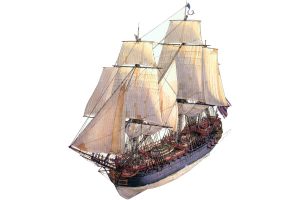The BHR was a French East Indiaman originally named Duc de Duras and later renamed Bonhomme Richard (“Good Man Richard”) by John Paul Jones to honor his friend Benjamin Franklin, author of Poor Richard’s Almanack, and who was instrumental in convincing the French to loan the U.S. more resources to fight the war. One of these resources was the BHR itself. The vessel measured 47 meters in length by 12 meters wide. She had two bower anchors weighing one ton each, and was equipped with 34 guns – six 18-pounders and 28 12-pounders. She carried a large amount of iron ballast, which was primarily pig iron and should be distinctive in her identification. The sizes of, and inscriptions on her guns will also be distinctive.
One of the features unique to this ship is the use of iron knees (instead of wood) in her construction. The size of frames and other hull components will also be helpful in identifying the wreck. It is likely that a positive identification of the wreck would at first depend on circumstantial evidence, and that no single feature alone will prove the wreck’s identity.





